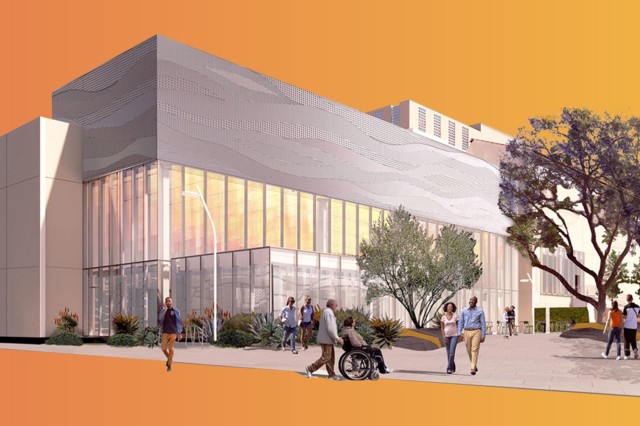A New Landscape
The Community Plaza of NHM Commons is a gathering place that has been imagined with pride and purpose.

Published November 11, 2024
Just outside the doors of the Museum's new wing, NHM Commons, which opened to the public on November 17, is a special outdoor space—the Community Plaza. Both understated and grand, the dynamic landscape is an ideal spot for events, gatherings, relaxation, and passage between Exposition Park’s many attractions and the Museum. But the sloping, tree-dotted expanse was also imagined and forged with pride and purpose by Los Angeles-based landscape architects Mia Lehrer + Associates (Studio-MLA) in collaboration with the Native American Advisory Council, artists, designers, and Museum horticulturalists.
Co-created with NHM's Native American Advisory Council, the garden is a living Land Acknowledgement of the Tongva (Gabrielino) territory on which NHM stands and honors the ongoing stewardship of our natural spaces by Southern California’s Native communities.
“There are touches of nature everywhere through the plants, through some of the representation of the rock. But there are touches of humanity everywhere, too,” said Milena Acosta, NHMLAC’s Associate Director of Community Engagement.
One example of this are the bedrock mortar installations created by Tongva artist Lazaro Arvizu Jr.. Two replicas of the mortars, also known as grinding stones, provide an interactive and educational experience, allowing visitors to learn about the significance of these tools—used to process acorns and other seeds—in the daily lives of Tribal communities in Southern California. Arvizu Jr. said he created these installations using heavy granite boulders from an industrial stone yard.
“We found the right stones and are creating an authentic experience of the culture and the descent peoples,” he said. Ancestors, he said, would peck out the mortar from the stone, the bowl shape starting off as just a dimple. In seasonal kitchens, they would process acorns that had fallen from nearby oaks. “There’s a symbiosis between the plants and the rocks, which support the root system. The relationship they have is so crucial.” “Having native people be part of the storytelling, that’s a new page in our story in L.A.,” said Arvizu. “The Natural History Museum is facilitating that as a place of learning.”


Photo 132784582, (c) Sula Vanderplank, some rights reserved (CC BY), uploaded by Sula Vanderplank
Santa Cruz Island ironwood

Honey mesquite trees have been used as a food source for tribes in the eastern Bakersfield area up into the Sierra Nevada.
1 of 1
Santa Cruz Island ironwood
Photo 132784582, (c) Sula Vanderplank, some rights reserved (CC BY), uploaded by Sula Vanderplank
Honey mesquite trees have been used as a food source for tribes in the eastern Bakersfield area up into the Sierra Nevada.
The Path of Water
The Plaza also features an installation depicting the waterways of the L.A. Basin. Look closely and you’ll see hundreds of bits of abalone shells shimmering on the pavement path like streams, organically connecting “islands” of rocks and flowering plants that symbolize the mountain ranges—Santa Monica, San Gabriel—that encircle the land here.
Most of the trees and shrubs coaxed into the soil in the Plaza garden by the Museum’s horticulture staff also have cultural significance to local tribes, said Daniel Feldman, NHM’s Senior Manager of Horticulture. There are four new oaks, the island oak native to the Channel Islands, as well as Santa Cruz ironwood, and honey mesquite trees which is a significant food source for tribes in the eastern Bakersfield area up into the Sierra Nevada. The Plaza landscape is peppered with island pink yarrow found in the Channel Islands and also white sage, a medicinally sacred plant, as well as Rhus aromatica or skunkbush, and deer grass, important plants used for weaving.
Samantha Morales Johnson Yang, who is on the Native American Advisory Council, said from the inception of this NHM Commons project they considered how they wanted to be represented.
“It really was just showing respect for our ancestors who took care of this land before the museum was here, and then trying to work to make that more visible and more known in the future.” She continued: “And the reason why we decided on the gardens was because we are a part of nature. Everyone is a part of nature, but that's especially a really important testament to native people. So it just felt natural to have that be the space that we really dedicated to our story.”
